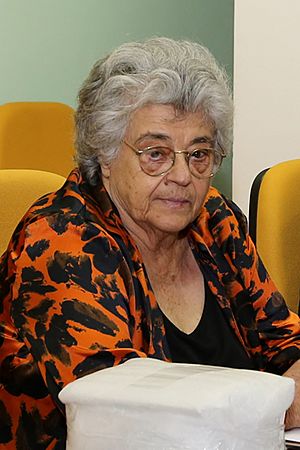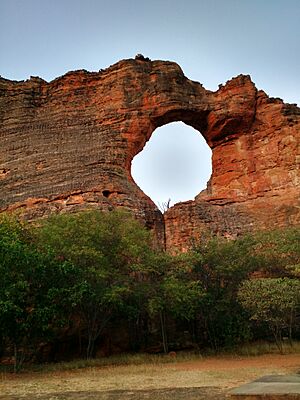Niède Guidon facts for kids
Quick facts for kids
Niède Guidon
|
|
|---|---|
 |
|
| Born | 12 March 1933 Jaú, São Paulo, Brazil
|
| Died | 4 June 2025 (aged 92) São Raimundo Nonato, Piauí, Brazil
|
| Nationality | Brazilian |
| Citizenship | Brazilian, French |
| Alma mater | University of São Paulo University of Paris (Sorbonne) |
| Known for | Conserving the natural and cultural heritage of the World Heritage Site Serra da Capivara National Park, Brazil |
| Awards | Prince Claus Award |
| Scientific career | |
| Fields | Archaeology |
| Institutions | American Man Museum Foundation; Serra da Capivara National Park in Piauí, Brazil |
Niède Guidon (born March 12, 1933 – died June 4, 2025) was a famous Brazilian archaeologist. She was known for her important work studying ancient human history in South America. She also worked hard to protect the Serra da Capivara National Park, which is a special place recognized by UNESCO as a World Heritage Site.
Niède Guidon studied in Brazil and France. For much of her career, she worked in Paris. Starting in the early 1970s, she led archaeological research in a region of Brazil called Southeast Piauí. There, thousands of ancient sites have been found. Her discoveries at these sites suggested that people lived in South America much earlier than many scientists believed. Her findings challenged a popular idea that the first people in the Americas were the Clovis people in North America. This created a lot of discussion among archaeologists.
She was the first president of the American Man Museum Foundation. This group helps support the Serra da Capivara National Park. Guidon received many awards for her work, including the Prince Claus Award.
Contents
Early Life and Discoveries
Niède Guidon was born in 1933 in Jaú, a city in São Paulo (state), Brazil. She later moved to the city of São Paulo. There, she studied Natural History at the University of São Paulo and worked at the Ipiranga Museum.
In 1963, Guidon organized an exhibit of ancient paintings at the Ipiranga Museum. A visitor from Serra da Capivara showed her photos of rock art from that area. Guidon immediately saw that these paintings were very different and special. She was amazed by how many there were and how varied they looked.
Her Work in Archaeology
In 1964, during a difficult time in Brazil, Niède Guidon moved to France. There, she earned her Ph.D. in prehistory at the Sorbonne University. From 1966 to 1977, she worked as a researcher in Paris. She also became a professor.
Guidon visited the rock shelters in Piauí herself. In 1973, she began her research there. In 1978, she convinced the French government to help fund an archaeological project in Piauí. Guidon led this project, which included researchers from many countries and local helpers.
In 1978, Guidon and other researchers asked the Brazilian government to create a protected area in the Serra da Capivara region. The Serra da Capivara National Park was created in 1979. It became a UNESCO World Heritage Site.
As the main archaeologist at the park, Guidon was in charge of protecting and studying its ancient sites. She and her team found more than 800 prehistoric sites. Over 600 of these sites have ancient paintings.
Guidon's most famous site is called Toca do Boqueirão da Pedra Furada. It is a large rock shelter with over 1,150 ancient images on its walls. Here, Guidon found thousands of tools and other items that seemed to be made by humans. She also found what looked like an ancient campfire, which she believed was about 48,700 years old. She suggested that humans might have arrived in Brazil around 100,000 years ago, possibly by boat from Africa. However, some other scientists, like Michael R. Waters, noted that there wasn't genetic proof in modern people to support such an early date.
The plants and animal remains found at this site, from about 10,000 years ago, show that the area used to be wetter and had more forests than it does today.
Guidon and her team published their findings in the British magazine Nature in 1986. They claimed to have found 32,000-year-old hearths and human tools. Even though these very early dates are still debated, Guidon's work showed that ancient people lived in the area. These people were hunters and gatherers who created amazing rock art.
Protecting the Park and Community Work
From 1986 until 2020, Guidon was the president of the American Man Museum Foundation (FUMDHAM). She and others started this group to protect the park's environment and rock art. The foundation also worked to help the local communities around the park.
In 1990, Guidon moved from Paris to São Raimundo Nonato, a town near the Serra da Capivara National Park. She lived there until her death in 2025.
As president of FUMDHAM, she helped create two museums: the Museum of the American Man and Nature's Museum. She also started a research center and many social projects. These projects focused on education, health care, and ways for local people to earn a living without harming the environment. She helped build five new schools in local communities. She also started a pottery business, Cerâmica de Capivara, which she later gave to local business owners.
Awards and Recognition
Niède Guidon received the Prince Claus Award and the Ford Conservation and Environment award. In 2005, she was one of 1000 women nominated for the Nobel Peace Prize.
See also
 In Spanish: Niède Guidon para niños
In Spanish: Niède Guidon para niños
- Toca da Tira Peia



